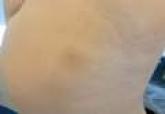Practical Pearls

Clinical Pearl: The Squeeze Maneuver
Plantar warts can be distinguished from calluses using the squeeze maneuver, a quick and easy method to diagnose plantar warts. This technique...
Dr. Blattner is from Good Samaritan Regional Medical Center, Corvallis, Oregon. Drs. Perry, Snider, and Young are from Silver Falls Dermatology, Salem, Oregon.
The authors report no conflict of interest.
Correspondence: Collin M. Blattner, DO, 3600 NW Samaritan Dr, Corvallis, OR 97330 (collin.blattner@gmail.com).

Alcohol can be used as a diagnostic aid for patients with dyschromia commonly seen in terra firma-forme dermatosis, confluent and reticulate papillomatosis, and acanthosis nigricans. Although biopsy can definitively determine diagnosis, proper utilization of isopropyl alcohol may avert unnecessary procedures.
Practice Gap
Conditions with dyschromia including terra firma-forme dermatosis (TFFD), confluent and reticulate papillomatosis (CARP), and acanthosis nigricans are difficult to distinguish from one another.
Diagnostic Tools
Since its development in 1920, dermatologists have utilized isopropyl alcohol in ways that exceed conventional antimicrobial purposes. If TFFP, CARP, and acanthosis nigricans are suspected, the first step in any algorithmic approach should be to rub the skin with an alcohol pad using firm continuous pressure in an attempt to remove pigmentation. Complete resolution of dyspigmentation strongly supports a diagnosis of TFFD1 and can be curative (Figure). Alcohol can similarly lighten CARP but to a lesser degree than TFFD.2 In contrast, acanthosis nigricans will display minimal to no improvement with isopropyl alcohol.
Practice Implications
Isopropyl alcohol has few side effects and each swab costs less than a dime. It is extremely cost effective compared to biopsy and subsequent pathology and laboratory costs. Patients appreciate a noninvasive initial approach, and it is rewarding to treat a cosmetically disturbing condition with ease.
Swabbing the skin with alcohol pads reflects light and improves visualization of veins that should be avoided during surgery. Alcohol-based gel inhibits bacterial colonization, reduces dermatoscope-related nosocomial infection, and enhances dermoscopic resolution.3 Alcohol swabs quickly remove gentian violet, which aids in porokeratosis diagnosis; the pathognomonic cornoid lamella of porokeratosis retains gentian violet.4 A solution of 70% isopropyl alcohol preserves myiasis larvae better than formalin, which causes larval tissue hardening. Alcohol also can be squeezed into the central punctum in myiasis as a form of treatment.5 In conclusion, alcohol represents a convenient, inexpensive, and helpful tool in the dermatologist’s armamentarium that should not be forgotten.

Plantar warts can be distinguished from calluses using the squeeze maneuver, a quick and easy method to diagnose plantar warts. This technique...
The dermatologic conditions that are most commonly encountered by nondermatologists are not well characterized, which can hamper efforts to train...
There is a paucity of data on the epidemiology of dermatologic disease in populations with skin of color. Our objective was to compare the most...
